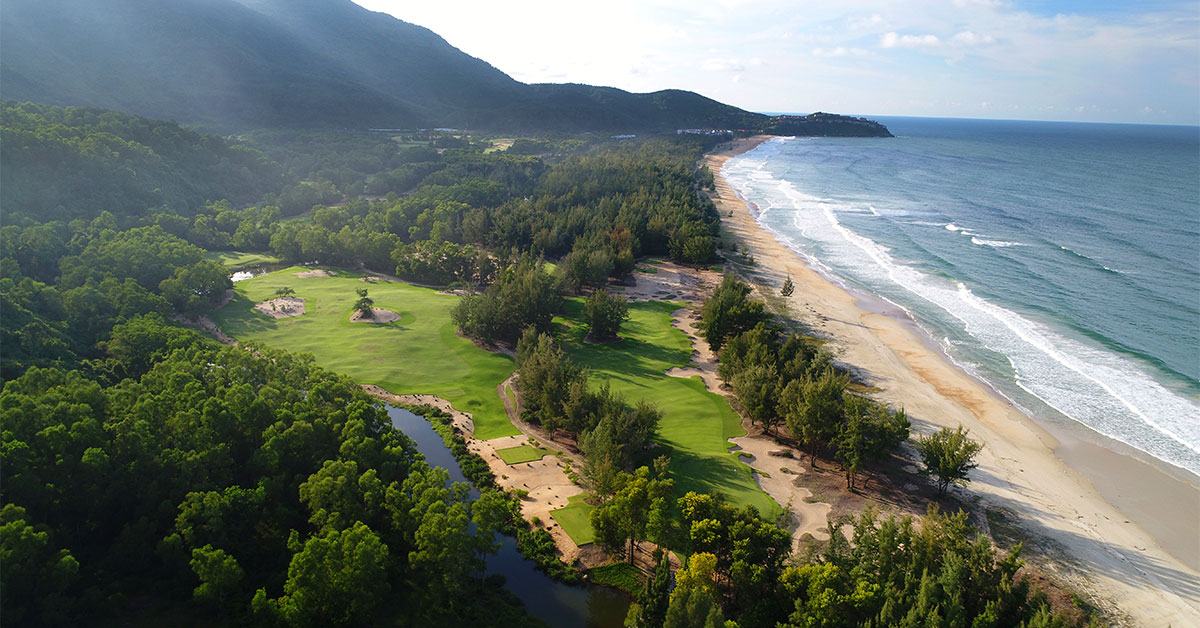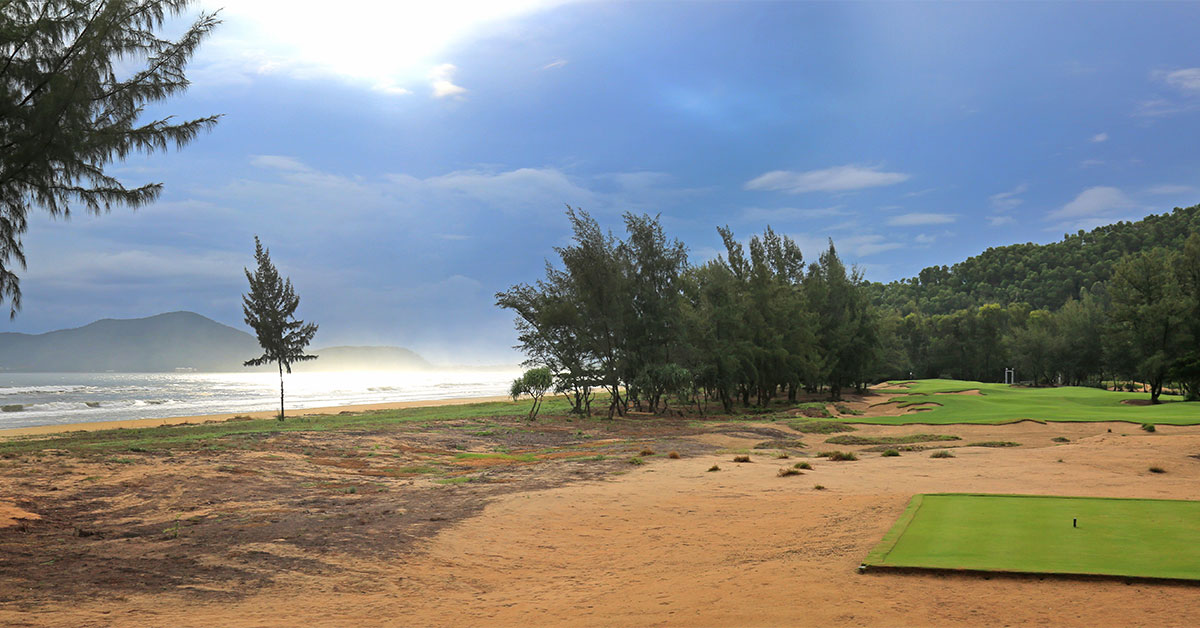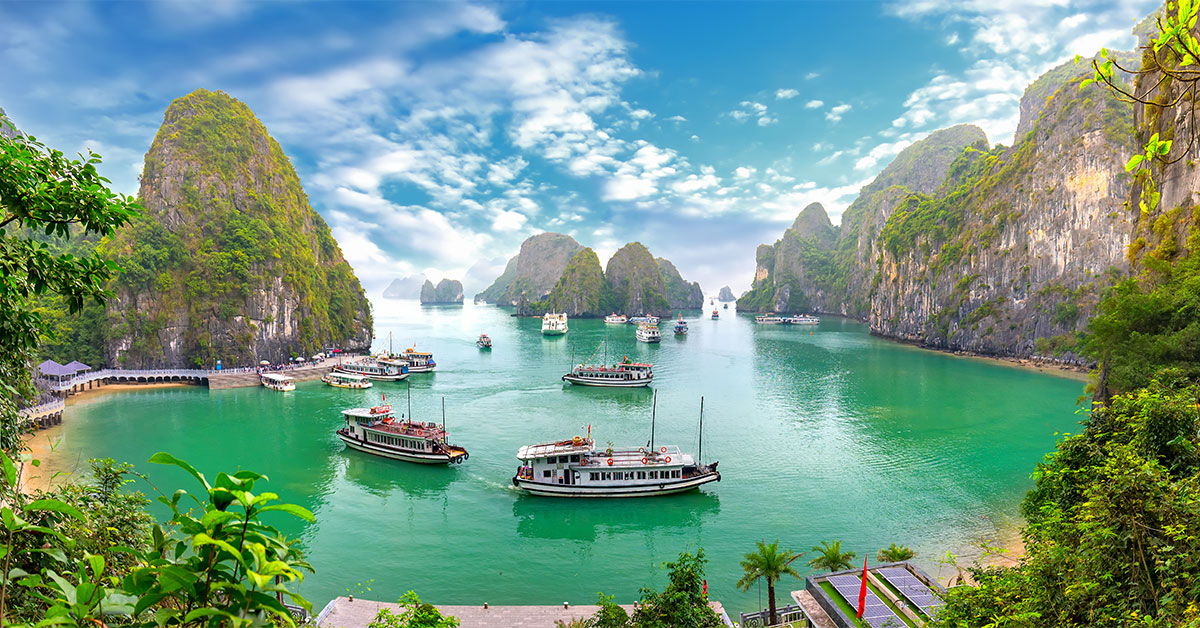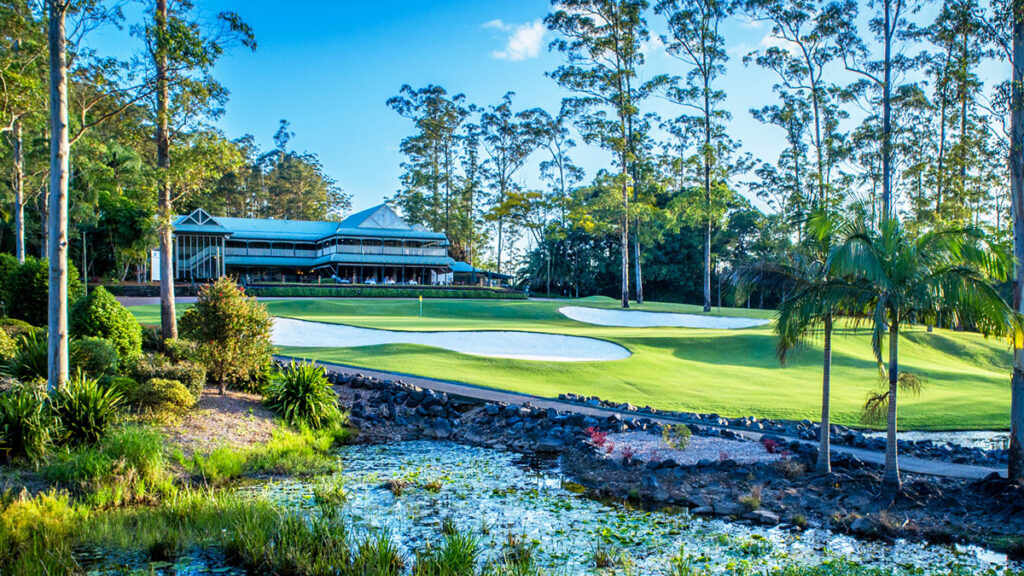Brett Geeves helps you overcome the sweltering heat and no apparent road rules to fully appreciate why Vietnam is one of the fastest-growing golf markets on the planet.
So, you are going to Vietnam to play golf? It’s important you eat the food and understand how to negate the likelihood of severe chafe.
Important! Eat the food. Negate the chafe.
My first port of call was Ho Chi Minh City (the old Saigon, but still called Saigon by most just to confuse visitors who were sleeping during their high-school history class), not for a stopover or a week of relaxation and merry golfin’. No, I was there to dodge traffic for two hours before a freeway that led me to a luxury resort called The Melia in Ho Tram. Ho Tram is home to The Bluffs golf course and its accommodation partner The Grand – which is part Casino, part beach-front resort, part accommodation stable – (an important note here is that you can’t access the casino without your passport), some other resorts and a whole pile of land sent from golf-course designer heaven.
Don’t be alarmed, scared or frightened by the traffic flow of Vietnam’s major centres. For Westerners – who abide by traffic lights, stop signs, double white lines and pedestrians having right of way – this mess of motorbikes, and the odd car, will seem like the parade of your major cities at Christmas when the cartels of bike gangs ride into town, carrying their teddy bears and donated toys for the local hospitals. Sure, it throws the city into chaos, but who is going to argue with them?
The rules of traffic in Vietnam are simple. The smaller you are, the more likely you are to be run over. Pushbikes give way to motorbikes; motorbikes give way to cars; cars give way to buses; buses give way to trucks. I know, it reads like the Indian learner’s exam; but there is one difference. While the cows are sacred in India and are ultimate holders of the road’s ownership, in Vietnam, they end up the hero of your bowl of Pho.
All of this is managed through a fierce amount of honking horns and rude gesticulating. But it works. And you should appreciate it.
Just like you should appreciate your body and respect it with talcum powder, an appropriate-fitting sports brief and dark-coloured attire when playing golf in Vietnam in 38 degrees and a humidity level rivalled only by putting your head in a fully functioning fan-forced oven. That is your bottom-maintenance lesson over – cut this part out and stick it to your golf clubs. You’ll need it.

Aussie Links Everywhere
The Melia Ho Tram – not attached or affiliated to The Bluffs course – is where I spent my time not playing the Greg Norman-designed Bluffs, only a 10-minute car ride away. Pool bar, designated kids pool, spa for massage and general pampering, a host of restaurants, hotel rooms (for couples) and villas (for families and rich couples) all situated on the beach. It’s what you’d expect from a company whose inspiration is the Hamptons.
Meanwhile, up the road about seven minutes in a speeding vehicle, is a golf experience like only one other: Barnbougle Dunes. I’ve not played true links golf in Scotland or Ireland – the home of links – but I’m fortunate enough to have Barnbougle Dunes just up the road from my place (in Tasmania, three-and-a-half hours equates to just up the road). It’s my links high point, and the standard to which I hold other golf courses.
Bizarrely, in a true three degrees of separation scenario only ever possible for Tasmanians, the current general manager of The Bluffs is a founding member of Barnbougle Dunes. A chap by the name of Gary Dixon, a touring pro in the 1990s and one of the keys to the success of Barnbougle as a course and now tourist destination.
The architecture of the Bluffs course is eerily similar. Like Barnbougle, the holes run exclusively parallel to the coast and share one of two wind directions: into it, or with it. They also use the same enormous dunes, wind and lack of certainty to target lines from the tee to provide your heart and mind with that butterfly feeling of uncertainty. The fairways are tighter than they appear through some visual design trickery and the pins are always cut tight into unseen swales on king-sized greens.
Where the two courses differ is total cost of project and the way in which each was built. Oh, and you can walk one and not the other – The Bluffs would test the savviest of hikers with its extreme inclines and the distance between greens and tees. At The Bluffs, your golf cart is your best friend.
When building Barnbougle Dunes, the total cost was reportedly $1.6 million. The course was there, all they had to do was find it, prepare the surfaces for the seedlings of grass and cut and fill bunkers. The Bluffs’ spend was 20 times higher. Yes, the clubhouse is a masterclass in construction excellence when compared to Barnbougle’s rustic wooden hut, but the course is a man-made pushing of sand and carving of land that removed jungle, trees and all natural vegetation to fit the required design. Elements of the design come from the natural landscape, but the largest portion of the course has been fabricated into links architecture; which would have purists suggesting it’s not a ‘true’ links course – just like T20 is an evil blight on the traditions of cricket as the humble gentleman’s game.
The other key difference – through no fault of the greens staff or management – is the condition of the course. Mother nature cares little for anyone. While it lays out in true links style – coastal, windy, huge undulating greens and fairways protected by the enormity of the dunes – it’s not possible to style your play to the true characteristics of links golf because of the continuity of rain that has every element playing soft and slow.
Year-round at Barnbougle, you can use the speed and firmness in the greens and surrounds to find difficult pin positions. High lofted wedge shots get less reward than a well mapped out bump-and-run – or putt – that uses the slopes to advantage. The Bluffs is soft and plays more like a traditional soft winter course. It’s ‘target golf’, a buzzword.
Aesthetically, I absolutely loved it. It breaks the traditions of links golf and the colours produced from the dryness of deadpan fairways and greens. It is like nothing I have seen. The way the colours of the sand and the marram grasses frame each hole against the immaculate green in the fairways and putting surfaces is like something from the painting easel of every golf designer’s dream. Tradition matters little for the everyday golfer, and for me this course sits at the top of the tree alongside Barnbougle as a golf experience.
And if it’s on-course accommodation you’re after, The Grand Ho Tram Strip is one of Asia’s premier leisure destinations and the first ever world-class integrated resort in Vietnam. Here you can choose from a collection of the most luxurious rooms – from ocean to golf-course views – to help you kick back in preparation for your date with The Bluffs. Be sure to look out for the regular play-and-stay deals on offer (thegrandhotram.com).

A Royal Visit
From the pampering of the Melia, the Gold Coast version of Barnbougle and the lost bets of the casino, it was on the bus, a plane, another bus and down the coast for a town called Hue – the once home of Vietnamese royalty, governance and power.
Our destination was a wellness centre – the Alba Wellness Retreat – where the nearest golf course was Laguna (75 minutes away), and then onwards to Danang (two hours). But what the resort lacked in immediate golf experience, it made up for in, well, wellness, I guess.
Upon arrival at Alba it was pitch-black dark and I was washed over by an unusual feeling. I’m an ocker bloke and that. Those classic tubes (660ml of beer) from 1997 didn’t scare me and I definitely ain’t scared of the dark! Before entering my room, I had already been overcome with a shifting energy. I’ll be honest; I was nervous. No, I was terrified. Can I be both? Because I was both. I couldn’t tell you why at the time, but there was something that had completely shifted both my psychology and physiology. I was noticeably hunched and quiet.
As I entered my dimly lit room, the first thing I saw was a Japanese-inspired swing hanging from the roof of the bathroom. While swings on their own aren’t scary, they are when your mind attaches images of torture to them. It fuelled what was already a haunting experience. And then when the hot showers wouldn’t spit out anything but scolding hot water, I was in another dimension. My mind was racing; I was seeing the white faces of Japanese horror films. That girl from “The Ring” was set to pop out of the phone at any moment. I had to turn all the lights on immediately.
At dinner, I explained this experience – which was continuing as I sat on a stool 22 sizes too small for me, causing my back to spasm, in a farmhouse, surrounded by the darkness of the jungle – to the general manager of the resort. He informed me that Hue was a hot spot for the brutality of the Vietnam War and the property itself was prominent in that warfare. The surrounding hills, jungles, streams and fields that now hosted us as guests were once a battleground.
There was a feeling of relief in knowing this, that my body and mind were in tune with the atrocities of the land, and that I was not just scared of the dark. It certainly made me stand a little taller, even though the light in my room didn’t ever turn off throughout the entirety of my stay.
It’s real. Believe it.
As I run away from Samara and never look back, we move forward to Laguna Lang Co, where the golf course is designed by Sir Nick Faldo and someone equally brilliant designed the accommodation.
It is rare that I stay somewhere that provides access to a golf course, and it’s the tones and styling of the interior decorating, the views from my villa and the crystal blue of the infinity pool that stays with me. Don’t get me wrong, the course is great, but the offering of the Laguna Lang Co region is simply extraordinary – from the Banyan Tree villas that sit atop the hill, whose view is the night-time lightshow from the below port, to Angsana, a more family-orientated resort which hosts an enormous pool and more recreational activities than a YMCA summer camp. There is a room to suit all family sizes, all budgets, all honeymooners and certainly all golfers. Yes, golfers, there is a chicken club sandwich available to room service.
The Laguna Lang Co course sets up like an all-terrain 4×4 advertisement. Sand, mountains, ocean, rivulets and king-sized boulders fill your visual as you attempt to navigate your way around sharply angled doglegs that are guarded by deep jungle growth.
Visually, this golf course is something else. On the third hole, a 500-metre par 5, there is a rice field that takes the shape of a 280-metre-long hazard along the right side. Beyond the fourth tee, you’ll see wild buffalo grazing in an open field.
The way Sir Nick has cut his way through this land maximises every possible part of the landscape. The rivulets flank the 10th, 12th and 13th holes. Water runs the length of the opener, the second and the right side of the tee shot for the par-5 15th. There is sand cut into every hole. Some bunkers are small and deep; others are large wastelands that seem to hold all the granules of the Praia do Cassino (the world’s longest beach). The ocean is a feature on the par-3 eighth and par-4 ninth. And the mountains are ever-present across all holes.
This is a fun course to play and one that demands an array of shot shapes from the tee and into the greens. Like Sir Nick, you’ll need to play smart golf on this one by plotting your way around the course. If you bring your bomber mentality to Laguna, you’ll end up back in your deluxe room crying into your deluxe towel.

Finish With A (Ba Na) Bang
Further down the road some 90 minutes from the Laguna Lang Co community is the third largest Vietnamese city, Danang, home to Montgomerie Links, Hoiana Shores and BRG Danang Golf Resort, all of which are must-plays. On the outskirts of the city, at the foot of Ba Na Hills, lays a behemoth of a golf course should you choose to take your ego and play from the black tees.
For me, and I’m sure most of you, there is a need to play any new course from the championship tees. I want to play the course as it was designed for the very best. Even as a higher handicap player, I wanted to attempt the shots a pro would face from the tee and into greens. But of all the courses I’ve played, Ba Na Hills takes its black markers to a whole new level. In this case, the black on offer is the same shade you’d wear to a funeral. It signifies mourning, grief and watery eyes from the amount of crying you’ll do.
I’m not the biggest hitter going around – it’s the fade I hit, and the removal of athleticism from my body through the lack of physical activity in the past eight years – but what I didn’t expect is for the design of the course to be out of my reach from the black tees on the majority of the par 4s and one par 5. The construct of the fairway bunkers is in line with the course’s name and surrounds. They’re mountainous. And their enormity sets up the course with additional colour and beauty while acting as increased punishment for wayward shots.
From the black tees, the fairway bunkers rarely come into play. I was hitting pretty steady drives of 260 to 270 metres and falling 10 paces short of most fairway hazards, leaving me some loooong irons into par 4s that weren’t ranked in the top 10 by index.
On the par-5 fifth, a 640-metre giant off the blacks, the carry to clear the water from the tee is 270 metres. Thankfully, I tugged my tee shot a little left, which bounced on the ladies tee and favourably onto the fairway… by exactly three centimetres.
From start to finish, I was in complete awe of this hole. The enormity of everything – the carry required on the tee shot, the way the bunkers seem to intertwine from both sides to present as though even the middle of the fairway was covered in sand, and the green – with its three unconventional tiers shaped like a droopy pancake falling off both sides of your hand – has more size and undulation than the waves greeting the Sydney to Hobart fleet as they hit Bass Strait. It is this golf hole that defines the black tee experience of Ba Na Hills. It’s breathtakingly huge!
When playing Ba Na Hills, make time for two rounds, because the black tees are a must-play. On your second round, allow the pro shop to guide you to the appropriate starting position based on your skill level to break 80.
The course itself can be split into two halves. The front nine is played on a traditional parkland style, while the back nine is a wave of land that provides some stunning elevation and sidehill lies on fairways that will feel like you are surfing Shipsterns Bluff for the first time.
The par-4 13th epitomises this with what feels like a 20-metre rise from the left side of the fairway to the top-side right. Driving it in a cart is like riding a roller coaster as the approach to the green makes the final descent by way of a 10-metre drop. But it’s the par-3 16th and par-4 17th that will leave Ba Na Hills imprinted into your memory forever. Both holes start from wildly elevated tees that offer stunning views of the seclusion of the holes and the enormity of the hills that have been surrounding you throughout the round. It’s a bizarre feeling wanting to take in the magnificence of both holes while salivating at the surrounding mountainous amphitheatre.
As if my tour through Vietnam wasn’t already Tasmanian enough, the general manager of Ba Na Hills is a chap by the name of Tim Haddon, who is also an Australian who formed part of the initial investment group for Barnbougle Dunes. It’s a small and bizarre world.
This is a golf course that must be seen to be believed. Sadly, I’ve run out of words to describe the light towers that line the course so you can play at night, the hospitality, the pristine practice facilities and the cable car that climbs to the top of Ba Na Hills. This course, too, sits atop the podium as a golf experience like few others.
When travelling to Vietnam, take your own clubs – the hire sets are all at least a decade old – and play as much golf as you can, eat as much food as your stomach allows and carry an abundance of talcum powder and blue/black outfits.
Trust me on all of this.
 Make Vietnam Your Greatest Golf Trip of All Time
Make Vietnam Your Greatest Golf Trip of All Time
If you want the ultimate Vietnam golf holiday, Australian company Go Golfing is a good place to start. Oceania’s most awarded golf tour company, Go Golfing’s mantra is to bring golfers together for the best time of their life. And they’re so good at delivering their promise, they enjoy one of the highest repeat customer rates in the golf travel industry.
More importantly, they have taken Aussie golfers to Vietnam for the past 10 years and are incredibly well-connected and experienced in the region, boasting the best guides and local access to the region’s top golf courses.
Through Go Golfing you’ll play all Vietnam’s trademark layouts, including the top-ranked The Bluffs Ho Tram.
“Playing golf in Vietnam comes with many perks,” says Go Golfing’s Peter McCarthy. “Go Golfing ensures you play with your caddie. For many, this will be their first experience of being pampered this way on the course. They even have an organised massage station on the course for their guests. You’ve never be pampered like this before.”
Go Golfing’s many years of experience in Vietnam means you’ll also cover the best cultural highlights. You’ll cruise along one of Vietnam’s most prized treasures, Halong Bay, take part in a fun-filled Vietnamese cooking class in Hoi An, and witness 400 years of Hoi An history through a spectacular outdoor show.
So popular is the company’s Vietnam tour, they’ve tailored one just for the ladies. “This is the ultimate girls’ trip,” McCarthy says. “There will be copious amounts of shopping, pampering, laughter, golf and sisterhood. If you’re planning any golf trip by yourself or with girlfriends, this is the one for you.”
Join Go Golfing for your next holiday to Vietnam with a fully escorted golf tour – mixed or ladies-only – or should you feel the need to enter an amateur golf tournament with all the bells and whistles of a professional event, you may wish to enter the Vietnam World Masters.




